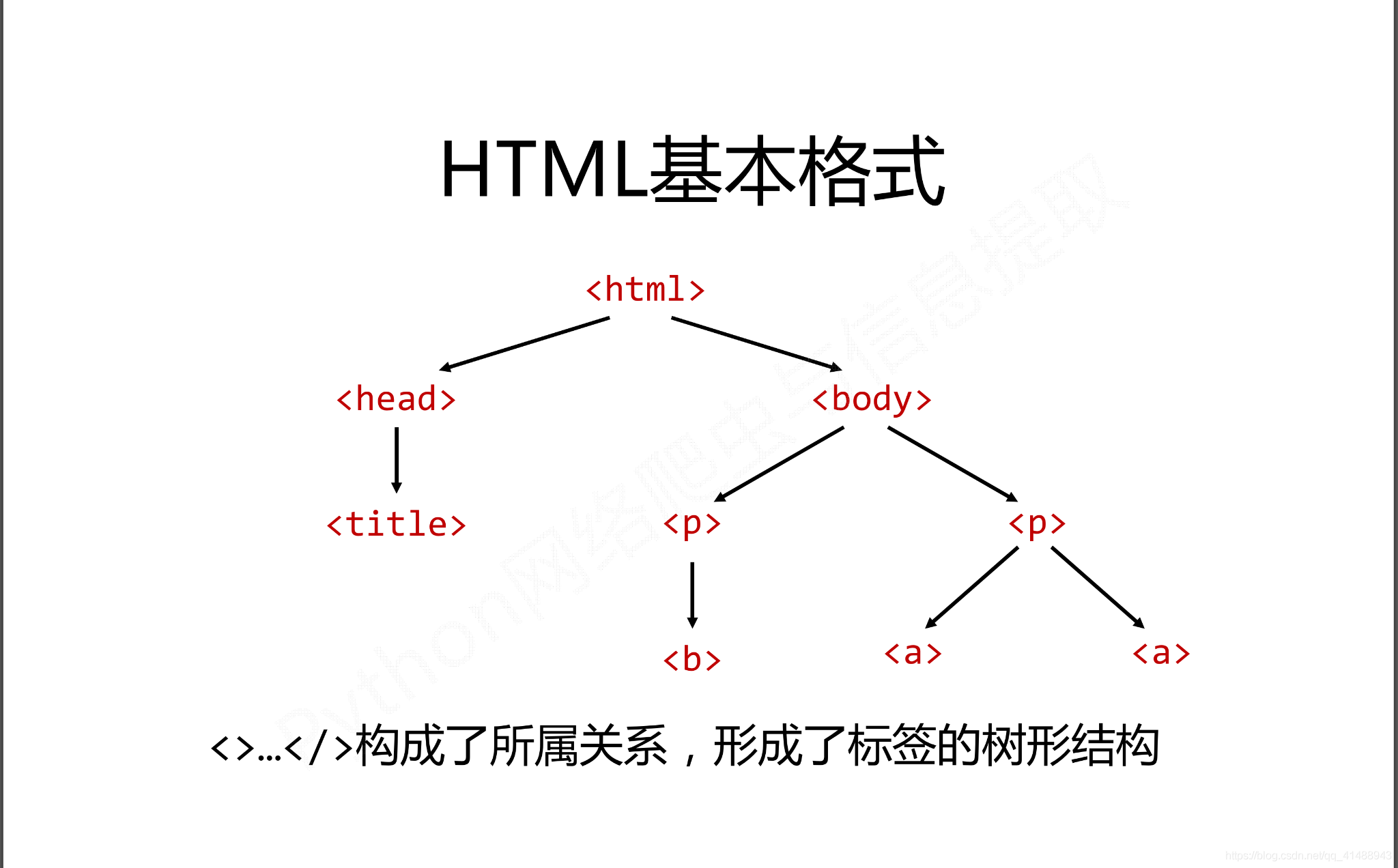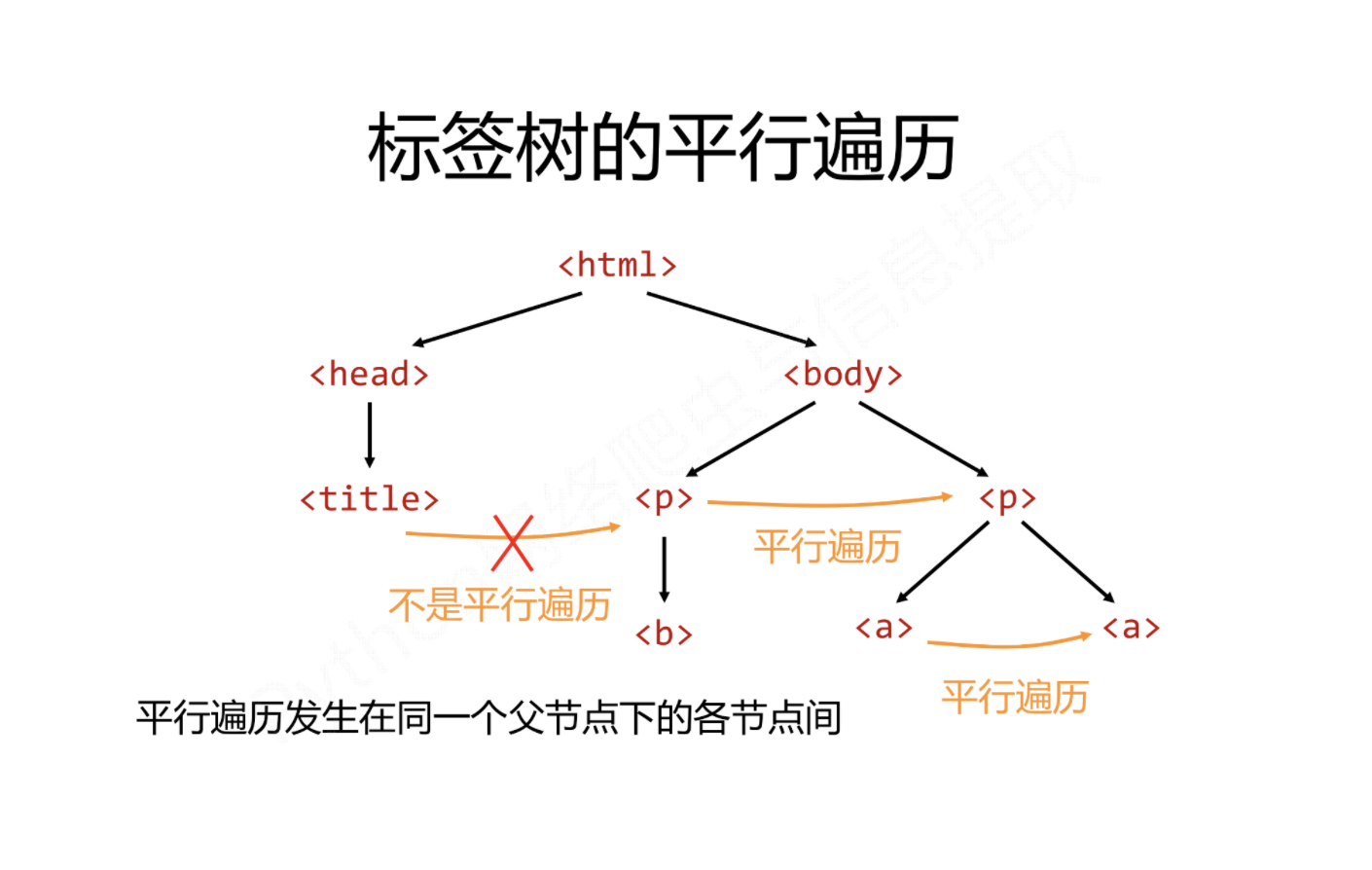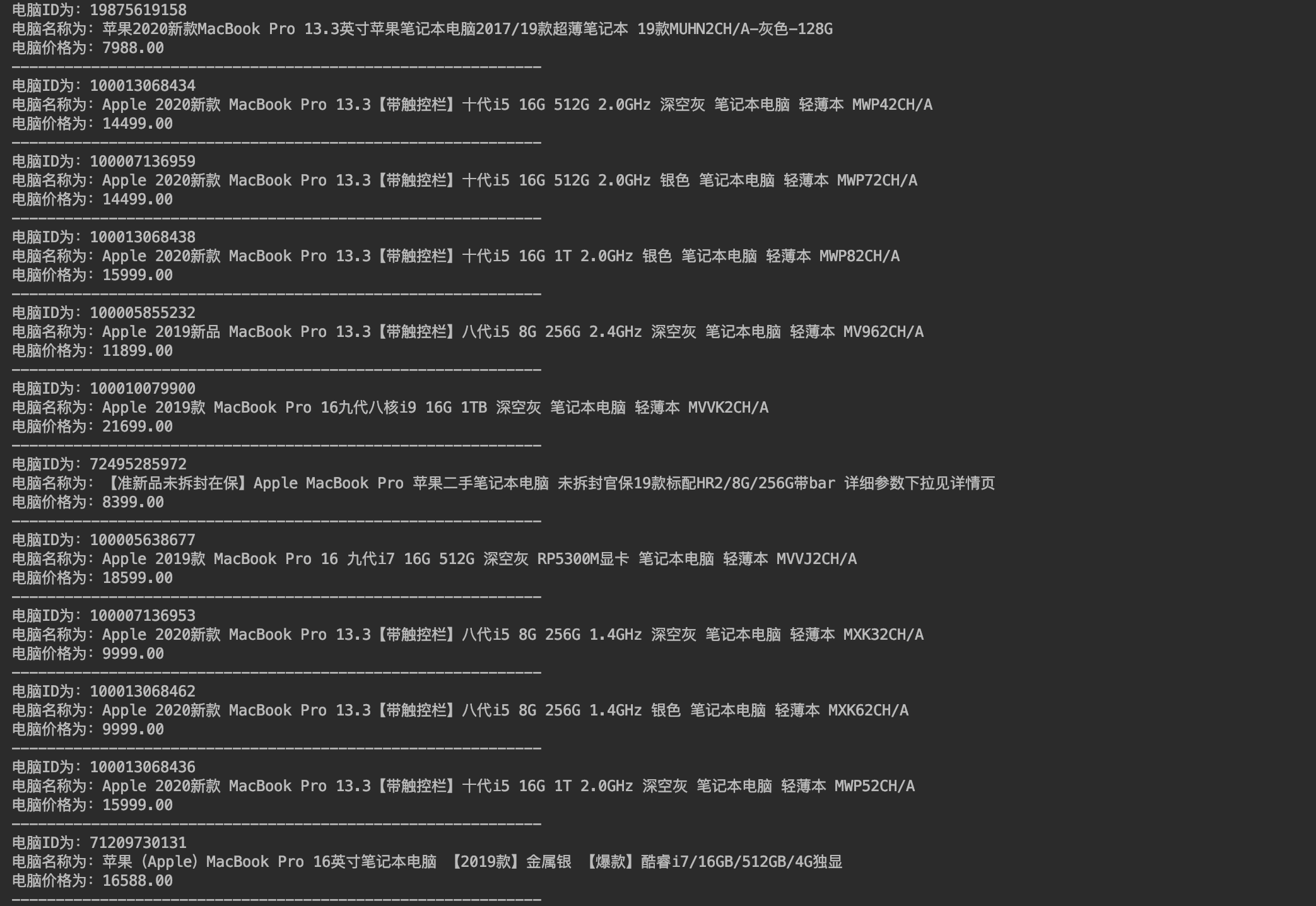python爬蟲之Beautiful Soup基礎知識+例項
阿新 • • 發佈:2020-08-12
#python爬蟲之Beautiful Soup基礎知識
>Beautiful Soup是一個可以從HTML或XML檔案中提取資料的python庫。它能通過你喜歡的轉換器實現慣用的文件導航,查詢,修改文件的方式。
需要注意的是,Beautiful Soup已經自動將輸入文件轉換為Unicode編碼,輸出文件轉換為utf-8編碼。因此在使用它的時候不需要考慮編碼方式,僅僅需要說明一下原始編碼方式就可以了。
## 一、安裝Beautiful Soup庫
使用pip命令工具安裝Beautiful Soup4庫
```python
pip install beautifulsoup4
```
##二、BeautifulSoup庫的主要解析器
|解析器|使用方法|條件|
|---|---|---|
|bs4的html解析器|BeautifulSoup(markup, 'html.parser')|安裝bs4庫|
|lxml的html解析器|BeautifulSoup(markup, 'lxml')|pip install lxml|
|lxml的lxml解析器|BeautifulSoup(markup, 'lxml')|pip install lxml|
|html5lib的解析器|BeautifulSoup(markup, 'html5lib')|pip install html5lib|
具體操作:
```python
html = 'https://www.baidu.com'
bs = BeautifulSoup(html, 'html.parser')
```
##三、BeautifulSoup的簡單使用
提取百度搜索頁面的部分原始碼為例:
```html
百度一下,你就知道
新聞
hao123
地圖
視訊
貼吧
更多產品
```
綜合requests和使用BeautifulSoup庫的html解析器,對其進行解析如下:
```python
import requests
from bs4 import BeautifulSoup
# 使用requests庫載入頁面程式碼
r = requests.get('https://www.baidu.com')
r.encoding = r.apparent_encoding
html = r.text
bs = BeautifulSoup(html, 'html.parser')
print(bs.prettify()) # prettify 方式輸出頁面
```
結果如下:
```
百度一下,你就知道
 新聞
hao123
地圖
視訊
貼吧
新聞
hao123
地圖
視訊
貼吧
```
在Tag標籤中最重要的就是html頁面中的nam和attrs屬性,使用方法如下:
```python
print(bs.a.name) # a
# 把a標籤的所有屬性列印輸出出來,返回一個字典型別
print(bs.a.attrs) # {'href': 'http://news.baidu.com', 'name': 'tj_trnews', 'class': ['mnav']}
# 等價 bs.a.get('class')
print(bs.a['class']) # ['mnav']
bs.a['class'] = 'newClass' # 對class屬性的值進行修改
print(bs.a) # 新聞
del bs.a['class'] # 刪除class屬性
print(bs.a) # 新聞
```
### NavigableString
NavigableString中的string方法用於獲取標籤內部的文字,程式碼如下:
```python
import requests
from bs4 import BeautifulSoup
# 使用requests庫載入頁面程式碼
r = requests.get('https://www.baidu.com')
r.encoding = r.apparent_encoding
html = r.text
bs = BeautifulSoup(html, 'html.parser')
print(bs.title.string) # 百度一下,你就知道
print(type(bs.title.string)) #
```
###Comment
Comment物件是一個特殊型別的NavigableString物件,其輸出的內容不包括註釋符號,用於輸出註釋的內容。
```python
from bs4 import BeautifulSoup
html = """"""
bs = BeautifulSoup(html, 'html.parser')
print(bs.a.string) # 新聞
print(type(bs.a.string)) #
```
### BeautifulSoup
bs物件表示的是一個文件的全部內容,大部分時候,可以把它當作Tag物件,支援遍歷文件樹和搜尋文件中描述的大部分方法。
因為Beautifulsoup物件並不是真正的HTML或者XML的tag,所以它沒有name和attribute屬性。所以BeautifulSoup物件一般包含值為"[document]"的特殊屬性.name
```python
print(bs.name) # [document]
```
## 五、基於bs4庫的HTML內容的遍歷方法
在HTML中有如下特定的基本格式,也是構成HTML頁面的基本組成成分。

而在這種基本的格式下有三種基本的遍歷流程
* 下行遍歷
* 上行遍歷
* 平行遍歷
三種遍歷方式分別是從當前節點出發,對之上、之下、平行的格式以及關係進行遍歷。
### 下行遍歷
下行遍歷分別有三種遍歷屬性,如下所示:
|屬性|說明|
|---|---|
|.contents|子節點的列表,將所有兒子節點存入列表。|
|.children|子節點的迭代型別,用於迴圈遍歷兒子節點。|
|.descendants|子孫節點的迭代型別,包涵所有子孫節點,用於迴圈遍歷。|
程式碼如下:
```python
import requests
from bs4 import BeautifulSoup
# 使用requests庫載入頁面程式碼
r = requests.get('https://www.baidu.com')
r.encoding = r.apparent_encoding
html = r.text
bs = BeautifulSoup(html, 'html.parser')
# 迴圈遍歷兒子節點
for child in bs.body.children:
print(child)
# 迴圈遍歷子孫節點
for child in bs.body.descendants:
print(child)
# 輸出子節點,以列表的形式
print(bs.head.contents)
print(bs.head.contents[0]) # 用列表索引來獲取它的某一個元素
```
### 上行遍歷
上行遍歷有兩種方式,如下所示:
|屬性|說明|
|---|---|
|.parent|節點的父親標籤。|
|.parents|節點先輩標籤的迭代型別,用於迴圈遍歷先輩節點,返回一個生成器。|
程式碼如下:
```python
import requests
from bs4 import BeautifulSoup
# 使用requests庫載入頁面程式碼
r = requests.get('https://www.baidu.com')
r.encoding = r.apparent_encoding
html = r.text
bs = BeautifulSoup(html, 'html.parser')
for parent in bs.a.parents:
if parent is not None:
print(parent.name)
print(bs.a.parent.name)
```
### 平行遍歷
平行遍歷有四種屬性,如下所示:
|屬性|說明|
|---|---|
|.next_sibling|返回按照HTML文字順序的下一個平行節點標籤。|
|.previous_sibling|返回按照HTML文字順序的上一個平行節點標籤。|
|.next_siblings|迭代型別,返回按照HTML文字順序的所有後續平行節點標籤。|
|.previous_siblings|迭代型別,返回按照HTML文字順序的前序所有平行節點標籤。|

程式碼如下:
```python
import requests
from bs4 import BeautifulSoup
# 使用requests庫載入頁面程式碼
r = requests.get('https://www.baidu.com')
r.encoding = r.apparent_encoding
html = r.text
bs = BeautifulSoup(html, 'html.parser')
for sibling in bs.a.next_siblings:
print(sibling)
for sibling in bs.a.previous_siblings:
print(sibling)
```
### 其它遍歷
|屬性|說明|
|---|---|
|.strings|如果Tag包含多個字串,即在子孫節點中有內容,可以用此獲取,然後進行遍歷。|
|.stripped_strings|與strings用法一致,可以去除掉那些多餘的空白內容。|
|.has_attr|判斷Tag是否包含屬性。|
## 六、檔案樹搜尋
使用bs.find_all(name, attires, recursive, string, **kwargs)方法,用於返回一個列表型別,儲存查詢的結果。
|屬性|說明|
|---|---|
|name|對標籤的名稱的檢索字串。|
|attrs|對標籤屬性值的檢索字串,可標註屬性檢索。|
|recursive|是否對子孫全部檢索,預設為True。|
|string|用與在資訊文字中特定字串的檢索。|
### name引數
如果是**指定的字串**:會查詢與字串完全匹配的內容,程式碼如下:
```python
a_list = bs.find_all("a")
print(a_list)
```
**使用正則表示式**:將會使用BeautifulSoup4中的search()方法來匹配,程式碼如下:
```python
import requests
from bs4 import BeautifulSoup
import re
# 使用requests庫載入頁面程式碼
r = requests.get('https://www.baidu.com')
r.encoding = r.apparent_encoding
html = r.text
bs = BeautifulSoup(html, 'html.parser')
t_list = bs.find_all(re.compile("p"))
for item in t_list:
print(item)
```
**傳入一個列表**:Beautifulsoup4將會與列表中的任一元素匹配到的節點返回,程式碼如下:
```python
import requests
from bs4 import BeautifulSoup
# 使用requests庫載入頁面程式碼
r = requests.get('https://www.baidu.com')
r.encoding = r.apparent_encoding
html = r.text
bs = BeautifulSoup(html, 'html.parser')
t_list = bs.find_all(["meta", "link"])
for item in t_list:
print(item)
```
傳入一個函式或方法:將會根據函式或者方法來匹配,程式碼如下:
```python
import requests
from bs4 import BeautifulSoup
# 使用requests庫載入頁面程式碼
r = requests.get('https://www.baidu.com')
r.encoding = r.apparent_encoding
html = r.text
bs = BeautifulSoup(html, 'html.parser')
def name_is_exists(tag):
return tag.has_attr("name")
t_list = bs.find_all(name_is_exists)
for item in t_list:
print(item)
```
### attrs引數
並不是所有的屬性都可以使用上面這種方法進行搜尋,比如HTML的data屬性,用與指定屬性搜尋。
```python
import requests
from bs4 import BeautifulSoup
# 使用requests庫載入頁面程式碼
r = requests.get('https://www.baidu.com')
r.encoding = r.apparent_encoding
html = r.text
bs = BeautifulSoup(html, 'html.parser')
t_list = bs.find_all(attrs={"class": "mnav"})
for item in t_list:
print(item)
```
### string引數
通過string引數可以搜尋文件中的字串內容,與name引數的可選值一樣,string引數接受字串,正則表示式,列表。
```python
import requests
from bs4 import BeautifulSoup
import re
# 使用requests庫載入頁面程式碼
r = requests.get('https://www.baidu.com')
r.encoding = r.apparent_encoding
html = r.text
bs = BeautifulSoup(html, 'html.parser')
t_list = bs.find_all(attrs={"class": "mnav"})
for item in t_list:
print(item)
# text用於搜尋字串
t_list = bs.find_all(text="hao123")
for item in t_list:
print(item)
# text可以通其它引數混合使用用來過濾tag
t_list = bs.find_all("a", text=["hao123", "地圖", "貼吧"])
for item in t_list:
print(item)
t_list = bs.find_all(text=re.compile("\d\d"))
for item in t_list:
print(item)
```
使用find_all()方法,常用到的正則表示式形式**import re**程式碼如下:
```python
bs.find_all(string = re.compile('python')) # 指定查詢內容
# 或者指定使用正則表示式要搜尋的內容
string = re.compile('python') # 字元為python
bs.find_all(string) # 呼叫方法模版
```
## 七、常用的find()方法如下
|方法|說明|
|---|---|
|<>find()|搜尋且只返回一個結果,字串型別,同.find_all()引數。|
| <>find_parent() |在先輩節點中返回一個結果,字串型別,同.find_all()引數。|
|<>.find_parents()|在先輩節點中搜索,返回列表型別,同.find_all()引數。|
|<>.find_next_sibling()|在後續平行節點中返回一個結果,同.find_all()引數。|
|<>.find_next_siblings()|在後續平行節點中搜索,返回列表型別,同.find_all()引數。|
|<>.find_previous_sibling()|在前序平行節點中返回一個結果,字串型別,同.find_all()引數。|
|<>.find_previous_siblings()|在前序平行節點中搜索,返回列表型別,同.find_all()引數。|
## 八、爬取京東電腦資料
爬取的例子直接輸出到螢幕。
(1)要爬取京東一頁的電腦商品資訊,下圖所示:

(2)所爬取的網頁連線:https://search.jd.com/search?keyword=macbook%20pro&qrst=1&suggest=5.def.0.V09&wq=macbook%20pro
(3)我們的目的是需要獲取京東這一個頁面上所有的電腦資料,包括價格,名稱,ID等。具體程式碼如下:
```python
#!/usr/bin/env python
# -*- coding:utf-8 -*-
import requests
from bs4 import BeautifulSoup
headers = {
'User-agent': "Mozilla/5.0 (Windows NT 10.0; WOW64) AppleWebKit/537.36 (KHTML, like Gecko) "
"Chrome/66.0.3359.139 Safari/537.36"
}
URL = "https://search.jd.com/search?keyword=macbook%20pro&qrst=1&suggest=5.def.0.V09&wq=macbook%20pro"
r = requests.get(URL, headers=headers)
r.encoding = r.apparent_encoding
html = r.text
bs = BeautifulSoup(html, 'html.parser')
all_items = bs.find_all('li', attrs={"class": "gl-item"})
for item in all_items:
computer_id = item["data-sku"]
computer_name = item.find('div', attrs={'class': 'p-name p-name-type-2'})
computer_price = item.find('div', attrs={'class': 'p-price'})
print('電腦ID為:' + computer_id)
print('電腦名稱為:' + computer_name.em.text)
print('電腦價格為:' + computer_price.find('i').string)
print('------------------------------------------------------------')
```
部分結果如下圖所示:

 新聞
hao123
地圖
視訊
貼吧
新聞
hao123
地圖
視訊
貼吧
關於百度 About Baidu
©2017 Baidu
使用百度前必讀
意見反饋
京ICP證030173號

